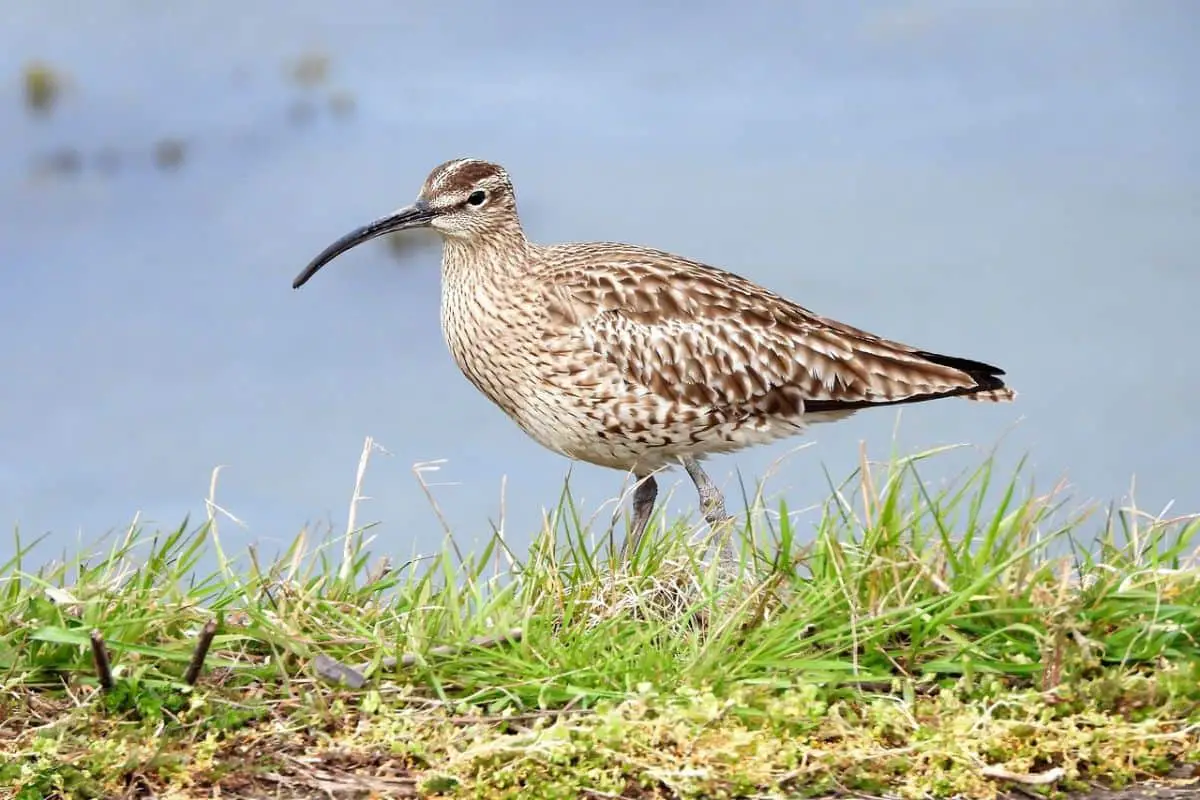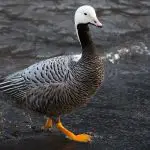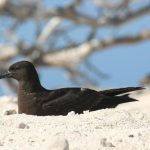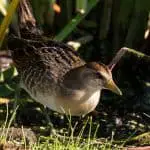Common Name: Whimbrel
Scientific Name: Numenius phaeopus| Size | Diet | Range in Hawaii | Status in Hawaii |
|---|---|---|---|
| 15 in. - 20 in. | crustaceans, insects, worms, mollusks, and small fish | Kaua'i, O'ahu, Moloka'i, Maui, and Hawai'i | Least Concern |
Whimbrels, also known as Numenius phaeopus, are fascinating shorebirds that are known for their long, curved bills and distinctive calls. While these birds are common in their breeding grounds in the Arctic tundra, they are also a non-breeding visitor and occasional winterer in Hawaii.
Whimbrels can be spotted on the islands of Kaua’i, O’ahu, Moloka’i, Maui, and Hawai’i during the winter months, making them a special sight for birdwatchers and nature enthusiasts alike.
In this article, we will explore the world of the whimbrel and discover what makes this bird so unique, including its migration patterns, habitat preferences, and behavior when it visits the beautiful islands of Hawaii.
Whimbrel
Appearance
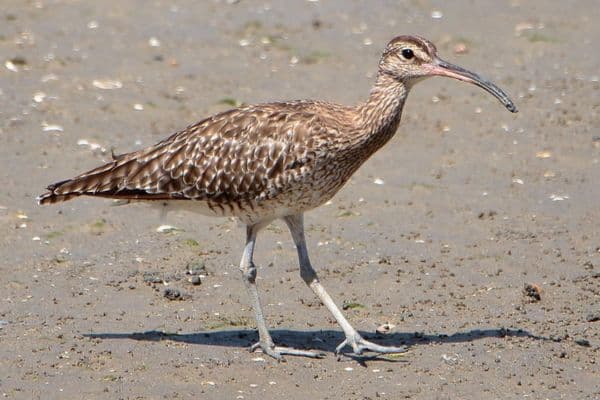
The Whimbrel is a medium-sized shorebird with a distinctive appearance. It measures approximately 15-20 inches in length, with a wingspan of about 30-40 inches. The bird has a long, curved bill that tapers to a point, allowing it to probe deep into the sand or mud in search of prey.
Its plumage is primarily brownish-gray, with a striped head and neck, and a prominent eyestripe. During flight, the Whimbrel displays a bold white stripe on its wings.
Diet
The Whimbrel has a varied diet that consists mainly of invertebrates. It feeds on a wide range of prey including crustaceans, insects, worms, mollusks, and small fish. The bird uses its long, curved bill to probe into the sand, mud, or shallow water to find food.
It also employs a unique foraging technique known as “hammering,” where it repeatedly strikes the ground with its bill to disturb hidden prey. The Whimbrel is an opportunistic feeder and adapts its diet to the available food sources in its coastal and marshland habitats.
Nesting
The Whimbrel nests in the Arctic tundra regions of North America and Eurasia. It builds its nest on the ground, usually in a well-concealed location among grasses or low vegetation. The female typically lays a clutch of 3-4 eggs, which are incubated by both parents for about 25-28 days.
After hatching, the chicks are precocial, meaning they are able to leave the nest shortly after birth and start feeding on their own. The parents provide care and protection to the chicks until they are able to fly, which usually takes around 4-5 weeks.
The nesting period is a critical time for the Whimbrel, as it must successfully raise its young in the harsh Arctic environment before embarking on its long migration to wintering grounds.
Behavior
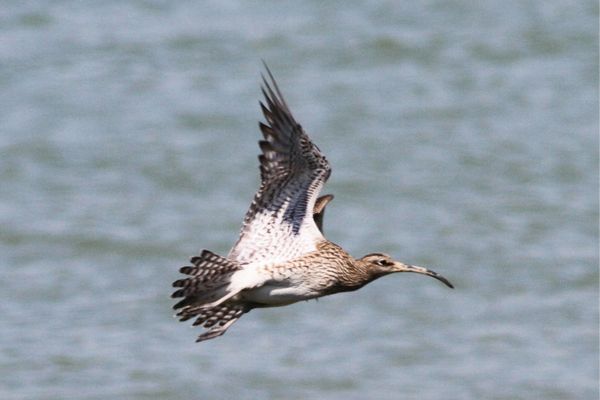
The Whimbrel exhibits fascinating behavior patterns throughout its life. It is known for its distinctive “whimbrel call” that consists of a series of melodic notes. This bird is highly migratory, undertaking long-distance journeys between breeding and wintering grounds.
During migration, Whimbrels often fly in large flocks known as “flights.” They are also known for their remarkable ability to navigate using celestial cues and geographical landmarks.
Whimbrels are primarily shorebirds and can be found foraging on coastal mudflats, beaches, and marshes, probing the ground with their long bills to find invertebrates and small crustaceans. They are also known to feed on berries and plant material during certain times of the year. The Whimbrel’s behavior is shaped by its environment and its remarkable adaptations for migration and feeding in coastal habitats.
Habitat
The Whimbrel is a versatile bird that inhabits a variety of coastal and wetland habitats. It can be found in saltmarshes, mudflats, estuaries, beaches, and coastal grasslands. During the breeding season, Whimbrels prefer open tundra habitats in the Arctic regions.
In their wintering grounds, they can be seen in a range of coastal habitats, including sandy beaches, mangroves, and saltwater lagoons. These birds are highly adaptable and can also be found in non-coastal habitats, such as wet meadows and agricultural fields, during migration.
Their habitat choice is primarily driven by the availability of food resources, as they rely on coastal areas for foraging on invertebrates and small prey. The Whimbrel’s habitat preferences reflect its dependence on coastal ecosystems for both breeding and foraging purposes.
Range
Whimbrels, are a non-breeding visitor and occasional winterer in Hawaii. These birds can be spotted on the islands of Kaua’i, O’ahu, Moloka’i, Maui, and Hawai’i during the winter months.
Whimbrels can be found in a variety of habitats, including beaches, rocky shores, and wetlands. While they are a rare sight, whimbrels are locally common in these areas during the winter season, providing a special opportunity for birdwatchers and nature enthusiasts to observe this unique shorebird in its Hawaiian range.
Conservation Status

The Whimbrel is currently classified as a species of “Least Concern” according to the IUCN Red List. However, specific populations and subspecies may face varying levels of threats and conservation concerns. The global population of Whimbrels is believed to be stable, but localized declines have been observed in certain regions due to habitat loss, disturbance, and hunting.
The species is protected by various international conservation agreements and regulations. Monitoring and research efforts are ongoing to better understand population trends and implement effective conservation measures to ensure the long-term survival of the Whimbrel.
Interesting Facts
1. Long-distance migrator
The Whimbrel is known for its remarkable long-distance migration, with some individuals traveling over 6,000 miles (9,600 kilometers) during their annual journeys between breeding and wintering grounds.
2. Unique “seven-whistle” call
The Whimbrel is known for its distinct vocalizations, including a call that consists of seven clear whistles. This distinctive sound can often be heard during their migration and breeding displays.
3. Breeding in Arctic tundra
During the breeding season, Whimbrels nest in the Arctic tundra, typically near wetlands or marshes. They construct shallow nests made of grass and lined with soft materials, where females lay 3-4 eggs.
4. Complex mating rituals
Whimbrels engage in elaborate courtship displays, which involve aerial acrobatics, calling, and ground-based performances. These displays serve to establish pair bonds and attract mates.
5. Cooperative breeding
In some instances, Whimbrels practice cooperative breeding, where non-breeding individuals assist in caring for the offspring of the breeding pair. This behavior is observed particularly in certain populations.
Frequently Asked Questions
1. Do Whimbrels mate for life?
Whimbrels do not mate for life. They form monogamous pairs during the breeding season but may choose new partners in subsequent years.
2. How can I identify a Whimbrel?
Whimbrels can be recognized by their long, downcurved bill, brownish plumage with distinct light and dark patterns, and their characteristic call, which is a series of seven whistling notes.
3. How long do Whimbrels live?
Whimbrels can live up to 20 years or more in the wild.
4. Are Whimbrels vocal birds?
Yes, Whimbrels are known for their distinctive calls. They produce a variety of vocalizations, including melodic whistles and trills.
